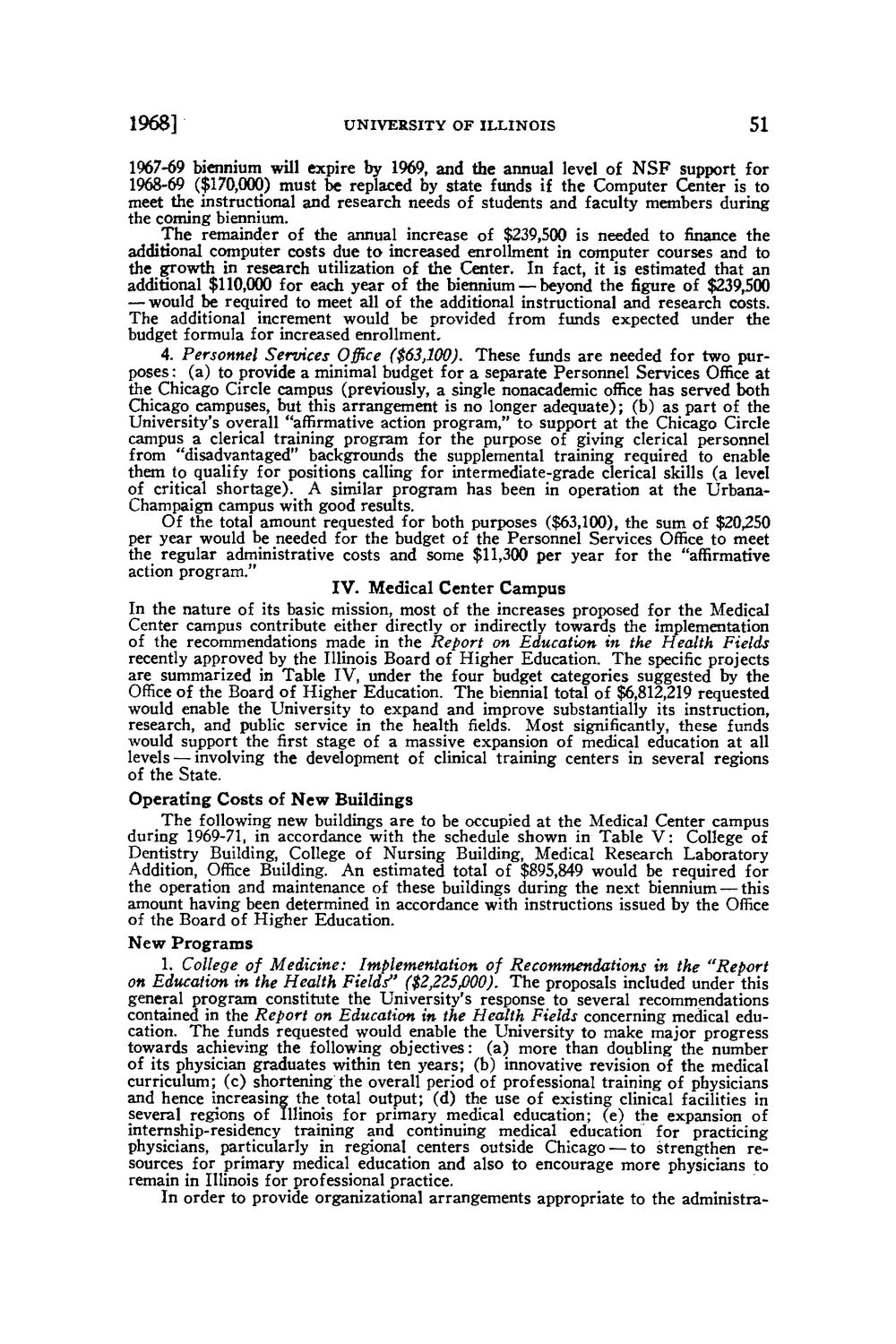| |
| |
Caption: Board of Trustees Minutes - 1970
This is a reduced-resolution page image for fast online browsing.

EXTRACTED TEXT FROM PAGE:
1968] UNIVERSITY OF ILLINOIS 51 1967-69 biennium will expire by 1969, and the annual level of N S F support for 1968-69 ($170,000) must be replaced by state funds if the Computer Center is to meet the instructional and research needs of students and faculty members during the coming biennium. T h e remainder of the annual increase of $239,500 is needed to finance the additional computer costs due to increased enrollment in computer courses and to the growth in research utilization of the Center. In fact, it is estimated that an additional $110,000 for each year of the biennium — beyond the figure of $239,500 — would be required to meet all of the additional instructional and research costs. The additional increment would be provided from funds expected under the budget formula for increased enrollment. 4. Personnel Services Office ($63,100). These funds are needed for two purposes : (a) to provide a minimal budget for a separate Personnel Services Office at the Chicago Circle campus (previously, a single nonacademic office has served both Chicago campuses, but this arrangement is no longer adequate); (b) as part of the University's overall "affirmative action program," to support at the Chicago Circle campus a clerical training program for the purpose of giving clerical personnel from "disadvantaged" backgrounds the supplemental training required to enable them to qualify for positions calling for intermediate-grade clerical skills (a level of critical shortage). A similar program has been in operation at the UrbanaChampaign campus with good results. Of the total amount requested for both purposes ($63,100), the sum of $20,250 per year would be needed for the budget of the Personnel Services Office to meet the regular administrative costs and some $11,300 per year for the "affirmative action program." I V . Medical Center C a m p u s In the nature of its basic mission, most of the increases proposed for the Medical Center campus contribute either directly or indirectly towards the implementation of the recommendations made in the Report on Education in the Health Fields recently approved by the Illinois Board of Higher Education. The specific projects are summarized in Table IV, under the four budget categories suggested by the Office of the Board of Higher Education. The biennial total of $6,812,219 requested would enable the University to expand and improve substantially its instruction, research, and public service in the health fields. Most significantly, these funds would support the first stage of a massive expansion of medical education at all levels — involving the development of clinical training centers in several regions of the State. O p e r a t i n g C o s t s of N e w Buildings The following new buildings are to be occupied at the Medical Center campus during 1969-71, in accordance with the schedule shown in Table V : College of Dentistry Building, College of Nursing Building, Medical Research Laboratory Addition, Office Building. An estimated total of $895,849 would be required for the operation and maintenance of these buildings during the next biennium — this amount having been determined in accordance with instructions issued by the Office of the Board of Higher Education. New Programs 1. College of Medicine: Implementation of Recommendations in the "Report on Education in the Health Fields" ($2,225fi00). The proposals included under this general program constitute the University's response to several recommendations contained in the Report on Education in the Health Fields concerning medical education. The funds requested would enable the University to make major progress towards achieving the following objectives: (a) more than doubling the number of its physician graduates within ten years; (b) innovative revision of the medical curriculum; (c) shortening the overall period of professional training of physicians and hence increasing the total output; (d) the use of existing clinical facilities in several regions of Illinois for primary medical education; (e) the expansion of internship-residency training and continuing medical education for practicing physicians, particularly in regional centers outside Chicago — to strengthen resources for primary medical education and also to encourage more physicians to remain in Illinois for professional practice. In order to provide organizational arrangements appropriate to the administra-
| |